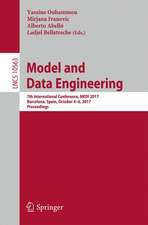Modeling with UML: Language, Concepts, Methods
Autor Bernhard Rumpeen Limba Engleză Paperback – 7 iun 2018
After a general introduction to UML and the choices made in the development of UML/P in Chapter 1, Chapter 2 includes a definition of the language elements of class diagrams and their forms of use as views and representations. Next, Chapter 3 introduces the design and semantic facets of the Object Constraint Language (OCL), which is conceptually improved and syntactically adjusted to Java for better comfort. Subsequently, Chapter 4 introduces object diagrams as an independent, exemplary notation in UML/P, and Chapter 5 offers a detailed introduction to UML/P Statecharts. Lastly, Chapter 6 presents a simplified form ofsequence diagrams for exemplary descriptions of object interactions. For completeness, appendixes A–C describe the full syntax of UML/P, and appendix D explains a sample application from the E-commerce domain, which is used in all chapters.
This book is ideal for introductory courses for students and practitioners alike.
| Toate formatele și edițiile | Preț | Express |
|---|---|---|
| Paperback (1) | 465.10 lei 43-57 zile | |
| Springer International Publishing – 7 iun 2018 | 465.10 lei 43-57 zile | |
| Hardback (1) | 499.15 lei 43-57 zile | |
| Springer International Publishing – 23 iun 2016 | 499.15 lei 43-57 zile |
Preț: 465.10 lei
Preț vechi: 581.37 lei
-20% Nou
Puncte Express: 698
Preț estimativ în valută:
89.01€ • 92.46$ • 73.94£
89.01€ • 92.46$ • 73.94£
Carte tipărită la comandă
Livrare economică 03-17 februarie 25
Preluare comenzi: 021 569.72.76
Specificații
ISBN-13: 9783319816357
ISBN-10: 3319816357
Ilustrații: XIV, 281 p. 175 illus., 3 illus. in color.
Dimensiuni: 155 x 235 mm
Greutate: 0.42 kg
Ediția:Softcover reprint of the original 1st ed. 2016
Editura: Springer International Publishing
Colecția Springer
Locul publicării:Cham, Switzerland
ISBN-10: 3319816357
Ilustrații: XIV, 281 p. 175 illus., 3 illus. in color.
Dimensiuni: 155 x 235 mm
Greutate: 0.42 kg
Ediția:Softcover reprint of the original 1st ed. 2016
Editura: Springer International Publishing
Colecția Springer
Locul publicării:Cham, Switzerland
Cuprins
Introduction.- Class Diagrams.- Object Constraint Language.- Object Diagrams.- State charts.- Sequence Diagrams.- A Language Representation with Syntax Class Diagrams.- B Java.- C The Syntax of the UML/P.- D Sample application: Internet-based Auction System.- References.
Recenzii
“This volume consists of six chapters and four appendices. … The introduction presents an overview of the UML profile (UML/P) language, with an emphasis on the current trend toward agile modeling. … I can recommend this book to system developers and academics … .” (Jolanta Mizera-Pietraszko, Computing Reviews, November, 2016)
Notă biografică
Bernhard Rumpe teaches at the RWTH Aachen Excellence University the use of agile, model-based development on the basis of UML. His research interests include models, modeling languages, DSLs, as well as their construction, analytical and generative use in development of products. With a number of publications, he has contributed to the standardization of UML and to a better use within development processes. He is author and editor of 21 books and Editor-in-Chief of the international Springer Journal on Software and Systems Modeling (SoSyM).
Textul de pe ultima copertă
This book presents a variant of UML that is especially suitable for agile development of high-quality software. It adjusts the language UML profile, called UML/P, for optimal assistance for the design, implementation, and agile evolution to facilitate its use especially in agile, yet model based development methods for data intensive or control driven systems.
After a general introduction to UML and the choices made in the development of UML/P in Chapter 1, Chapter 2 includes a definition of the language elements of class diagrams and their forms of use as views and representations. Next, Chapter 3 introduces the design and semantic facets of the Object Constraint Language (OCL), which is conceptually improved and syntactically adjusted to Java for better comfort. Subsequently, Chapter 4 introduces object diagrams as an independent, exemplary notation in UML/P, and Chapter 5 offers a detailed introduction to UML/P Statecharts. Lastly, Chapter 6 presents a simplified form ofsequence diagrams for exemplary descriptions of object interactions. For completeness, appendixes A–C describe the full syntax of UML/P, and appendix D explains a sample application from the E-commerce domain, which is used in all chapters.
This book is ideal for introductory courses for students and practitioners alike.
After a general introduction to UML and the choices made in the development of UML/P in Chapter 1, Chapter 2 includes a definition of the language elements of class diagrams and their forms of use as views and representations. Next, Chapter 3 introduces the design and semantic facets of the Object Constraint Language (OCL), which is conceptually improved and syntactically adjusted to Java for better comfort. Subsequently, Chapter 4 introduces object diagrams as an independent, exemplary notation in UML/P, and Chapter 5 offers a detailed introduction to UML/P Statecharts. Lastly, Chapter 6 presents a simplified form ofsequence diagrams for exemplary descriptions of object interactions. For completeness, appendixes A–C describe the full syntax of UML/P, and appendix D explains a sample application from the E-commerce domain, which is used in all chapters.
This book is ideal for introductory courses for students and practitioners alike.
Caracteristici
Introduces UML as the modeling language of choice for software projects Includes an extensive application example for an auction system Closes the often-encountered “implementation gap” between models and code by a tight semantic and syntactic integration of Java and UML/P. Includes supplementary material: sn.pub/extras






















